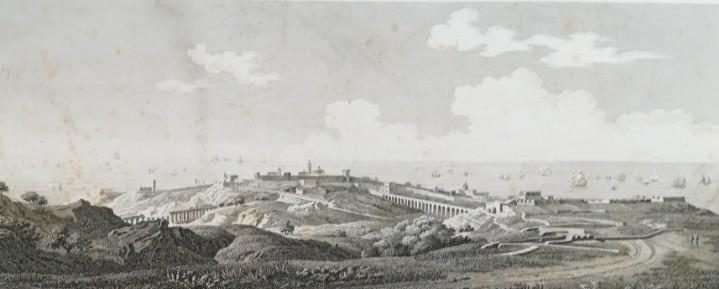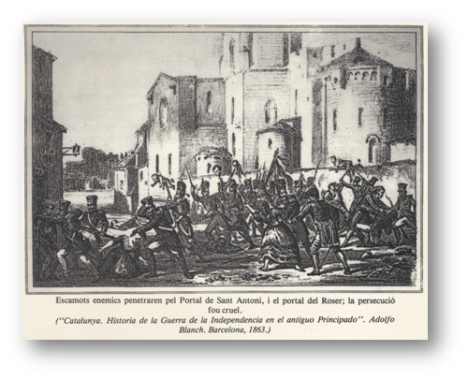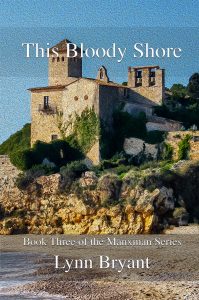 This Bloody Shore is Book Three of the Manxman Series which takes Captain Hugh Kelly and First Lieutenant Alfred Durrell to the rocky coastline of Spain and the fortress town of Tarragona.
This Bloody Shore is Book Three of the Manxman Series which takes Captain Hugh Kelly and First Lieutenant Alfred Durrell to the rocky coastline of Spain and the fortress town of Tarragona.
It is 1811.
After the disastrous Walcheren campaign, Britain’s hopes of defeating the French on land rest with Wellington’s army in Portugal. Over to the east, Bonaparte’s attention turns to Catalonia where he has ordered General Suchet to capture the coastal town of Tarragona from the Spanish, and promised him his Marshal’s baton if he succeeds.
Captain Hugh Kelly RN and First Lieutenant Alfred Durrell of HMS Iris are sent to join a squadron under Commodore Codrington which is providing naval support to the beleaguered Spanish garrison. Tarragona has withstood French assaults before, but this time Suchet’s hunger for promotion combined with rivalry among the Spanish commanders have left the town in a precarious position.
Captain Gabriel Bonnet of the 30th légère, a scarred veteran of Bonaparte’s wars has long since abandoned his youthful ideals and just wants to survive and do his job. However, mistakes made by his battalion commander force Bonnet to shoulder more responsibility while chance encounters with a Spanish woman trying to survive alone and an arrogant young Spanish officer remind him that there is more to honour than winning a battle.
As the French bombardment of the town reaches its savage climax, it becomes clear that neither garrison nor civilians can expect mercy from Suchet’s invading army. Hugh Kelly and the rest of the Royal Navy squadron face the prospect of managing a daring and dangerous evacuation from the bloody shore of Tarragona.
I’ve had the same problem with taking photographs of Tarragona as I had with Castro Urdiales in An Unmerciful Incursion, which is that the difficulties of travel over the past couple of years made it impossible to get there for our usual research trip. On this occasion, however, I think it would have been challenging anyway, because so much of Tarragona has been modernised. There’s enough of the old town to get a sense of the streets and buildings which would have been familiar to my characters, but it proved impossible to find a really good stock photograph of the coast which would fit in with my book.
What we did find was some very good shots of the fortress of Tamarit which is a few miles along the coast. It might not be Tarragona, but I think it gives a good sense of the rocky coast and the challenges the Royal Navy might have experienced trying to keep the town supplied with troops, food and weapons.
What I did find, much to my joy, was a series of artworks which in some ways do a better job of illustrating this book than modern photographs could do. There are portraits of the three main commanders at Tarragona and in addition each of them subsequently published an account of the siege which was pure gold for research purposes.
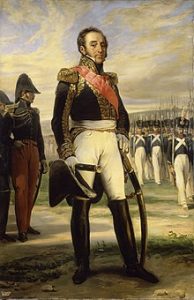 The French were led by General Louis-Gabriel Suchet who was Napoleon’s most consistently successful general in Spain. As mentioned in the book, Suchet was promised that the capture of Tarragona would guarantee his promotion to Marshal and he was the only French Marshal to win his baton in the Peninsula. Suchet’s memoirs are available online and give a vivid account of the campaign.
The French were led by General Louis-Gabriel Suchet who was Napoleon’s most consistently successful general in Spain. As mentioned in the book, Suchet was promised that the capture of Tarragona would guarantee his promotion to Marshal and he was the only French Marshal to win his baton in the Peninsula. Suchet’s memoirs are available online and give a vivid account of the campaign.
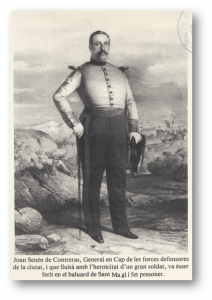 The Spanish garrison was commanded by Juan Senen de Contreras, a general with a fine reputation who considered himself to have been abandoned in an impossible posting. I enjoyed portraying Contreras, whose account of the siege is available here. He comes across as very well meaning but not especially likeable.
The Spanish garrison was commanded by Juan Senen de Contreras, a general with a fine reputation who considered himself to have been abandoned in an impossible posting. I enjoyed portraying Contreras, whose account of the siege is available here. He comes across as very well meaning but not especially likeable.
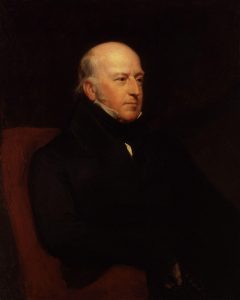 Finally, we come to Commodore Edward Codrington who is one of my absolute favourite characters to write. Codrington’s memoirs and letters were published by his daughter and he’s a bit like Wellington in that his personality shines through the pages. There are aspects of Codrington which are problematic and I’ve talked about those in a separate post, but he’s pure gold for a novelist.
Finally, we come to Commodore Edward Codrington who is one of my absolute favourite characters to write. Codrington’s memoirs and letters were published by his daughter and he’s a bit like Wellington in that his personality shines through the pages. There are aspects of Codrington which are problematic and I’ve talked about those in a separate post, but he’s pure gold for a novelist.
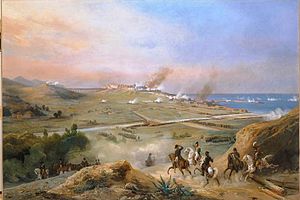 With regard to the siege itself, I found several fabulous pieces of art. The first one is a view of the siege from the French lines by Jean-Charles-Joseph Rémond (1795–1875) This gives an impression of what my French captain, Gabriel Bonnet might have seen looking out over the bombardment of the town.
With regard to the siege itself, I found several fabulous pieces of art. The first one is a view of the siege from the French lines by Jean-Charles-Joseph Rémond (1795–1875) This gives an impression of what my French captain, Gabriel Bonnet might have seen looking out over the bombardment of the town.
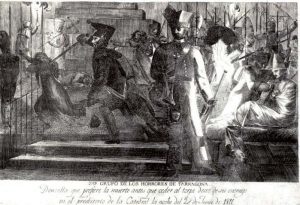 There is also a series of rather grim anonymous engravings of the horrors of the storming of the town. I haven’t yet been able to work out the original source of these. I found them on Wikimedia but they’re fairly widely available and have been used as illustrations in a number of books and websites about the siege. They give a painful sense of what the garrison and the citizens of Tarragona faced once the French broke through.
There is also a series of rather grim anonymous engravings of the horrors of the storming of the town. I haven’t yet been able to work out the original source of these. I found them on Wikimedia but they’re fairly widely available and have been used as illustrations in a number of books and websites about the siege. They give a painful sense of what the garrison and the citizens of Tarragona faced once the French broke through.
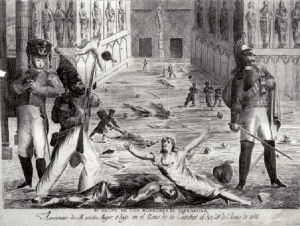
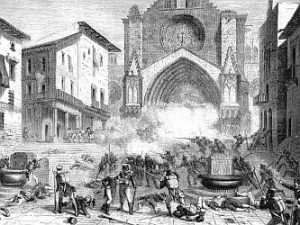 This engraving clearly depicts the scene at the cathedral where some of the last defenders of the upper town fought and died on the steps and in the square outside. This scene is depicted in the book as Angel Cortez and Oscar Garcia prepare to make a final defence. Some of these pictures made a strong impression on me when I was writing the book. It was rather like the paintings I found of the destruction of Castro Urdiales. While it’s great to be able to visit the modern towns, and I have every intention of doing so, it’s very moving to look at some of these old pictures to get an artist’s impression of the events of those terrible weeks in 1811.
This engraving clearly depicts the scene at the cathedral where some of the last defenders of the upper town fought and died on the steps and in the square outside. This scene is depicted in the book as Angel Cortez and Oscar Garcia prepare to make a final defence. Some of these pictures made a strong impression on me when I was writing the book. It was rather like the paintings I found of the destruction of Castro Urdiales. While it’s great to be able to visit the modern towns, and I have every intention of doing so, it’s very moving to look at some of these old pictures to get an artist’s impression of the events of those terrible weeks in 1811.
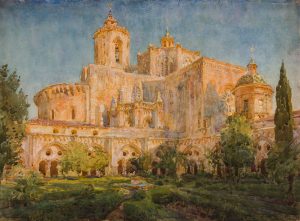 I found this painting by Henry Charles Brewer really useful to get a sense of the majesty of the cathedral. It has a lovely sense of light, which inspired a few descriptive passages in the book. There’s a real contrast between the beauty of this building and the brutal scenes described in the book and I found myself wondering if any of the people present had the same thoughts. Probably not. They’d have been too busy trying to survive.
I found this painting by Henry Charles Brewer really useful to get a sense of the majesty of the cathedral. It has a lovely sense of light, which inspired a few descriptive passages in the book. There’s a real contrast between the beauty of this building and the brutal scenes described in the book and I found myself wondering if any of the people present had the same thoughts. Probably not. They’d have been too busy trying to survive.
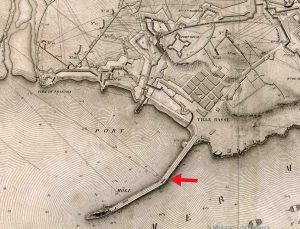 I also love old maps when it comes to research. They can be particularly helpful when there have been huge changes to the landscape over the past two hundred years. This map is from 1811 and I used it all the time in working out where the various skirmishes and attacks took place during the siege.
I also love old maps when it comes to research. They can be particularly helpful when there have been huge changes to the landscape over the past two hundred years. This map is from 1811 and I used it all the time in working out where the various skirmishes and attacks took place during the siege.
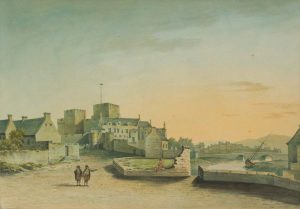
The early part of the book takes place in England and the Isle of Man. I’ve done a fair bit of research in this era for previous books, but it’s still lovely to find artwork which gives a sense of the period. This is a gorgeous view of Castle Rushen where Hugh, Roseen and Durrell attend a ball before the Iris sails for the Mediterranean and where Hugh finally runs into the unpleasant Orry Gelling, a man he’s been wanting to have a chat with for a while…
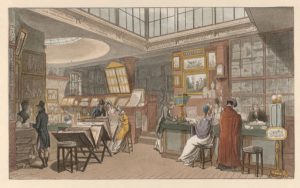 This is one of my absolute favourites. Back in London, Durrell takes his younger sister Abigail shopping for writing supplies. Naturally they go to Ackermann’s and I was overjoyed to find this fabulous print of the shop as it would have appeared when Durrell met Faith Collingwood there in 1811. Once I’d examined this picture, that scene just wrote itself.
This is one of my absolute favourites. Back in London, Durrell takes his younger sister Abigail shopping for writing supplies. Naturally they go to Ackermann’s and I was overjoyed to find this fabulous print of the shop as it would have appeared when Durrell met Faith Collingwood there in 1811. Once I’d examined this picture, that scene just wrote itself.
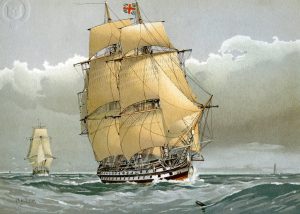 Finally, the Iris herself. I’ve spoken before about my frustration in discovering that despite my usual careful research, I’ve managed to use a ship name which was already in use at the time. I couldn’t bear to change it though as by the time I discovered, I’d already written two books in the series and I loved the name too much. For once I’ve let the error stand, with many apologies. My fictional Iris is a 74-gun third rater and there are many paintings of those out there but this is one of my favourites.
Finally, the Iris herself. I’ve spoken before about my frustration in discovering that despite my usual careful research, I’ve managed to use a ship name which was already in use at the time. I couldn’t bear to change it though as by the time I discovered, I’d already written two books in the series and I loved the name too much. For once I’ve let the error stand, with many apologies. My fictional Iris is a 74-gun third rater and there are many paintings of those out there but this is one of my favourites.
I’m delighted that This Bloody Shore is finally ready for my readers to enjoy. When we eventually get to Tarragona with a camera, I’ll update this with some of our own photos, but to be honest I think these paintings and engravings might do a better job of setting the scene in 1811, when General Gabriel Suchet set out to win his marshal’s baton on the bloody shore of Tarragona.

